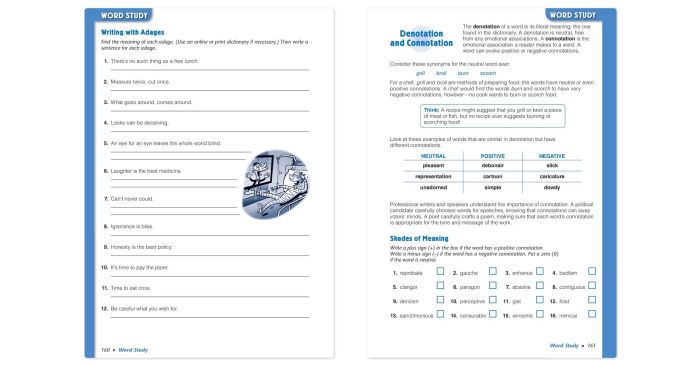Embark on a journey towards Spanish language mastery with the FTCE Spanish K-12 Study Guide. This comprehensive resource empowers you with the knowledge and strategies to conquer the FTCE Spanish K-12 exam and unlock your teaching potential.
Delve into the key content domains, assessment strategies, and study resources that will guide you towards success. Master the intricacies of Spanish language instruction and prepare to inspire future generations of Spanish speakers.
FTCE Spanish K-12 Study Guide Overview
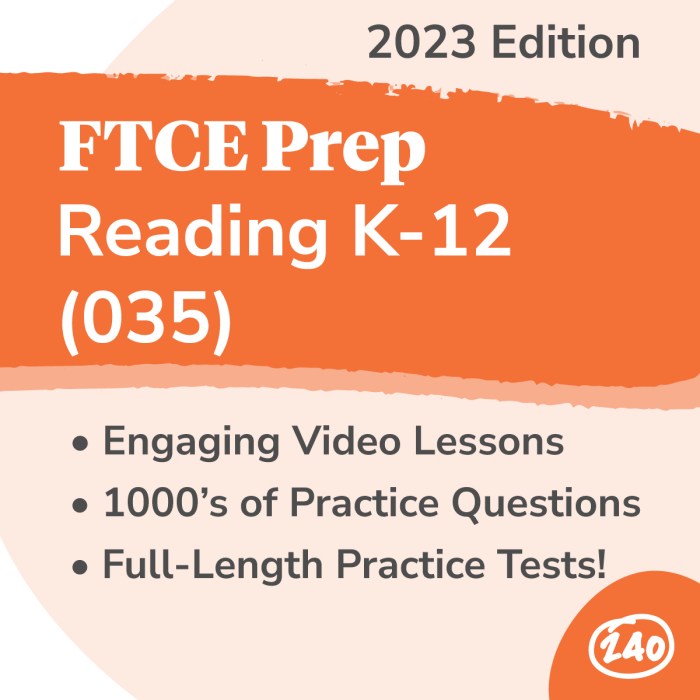
The FTCE Spanish K-12 study guide is a comprehensive resource designed to help candidates prepare for the Florida Teacher Certification Examination (FTCE) in Spanish K-12. This guide provides a detailed overview of the exam format, content areas, and assessment standards, ensuring that candidates have the knowledge and skills necessary to succeed on the exam and become certified to teach Spanish in Florida.
Target Audience
The FTCE Spanish K-12 study guide is primarily intended for individuals who are seeking certification to teach Spanish in grades K-12 in the state of Florida. This includes:
- Pre-service teachers enrolled in teacher education programs
- In-service teachers seeking additional certification in Spanish
- Individuals with a bachelor’s degree in Spanish who wish to pursue teaching as a career
Exam Format
The FTCE Spanish K-12 exam is a computer-based test that consists of 120 multiple-choice questions. Candidates have three hours to complete the exam. The exam is divided into three subtests:
- Subtest 1: Language Skills and Knowledge (60 questions)
- Subtest 2: Reading (30 questions)
- Subtest 3: Writing (30 questions)
Content Domains
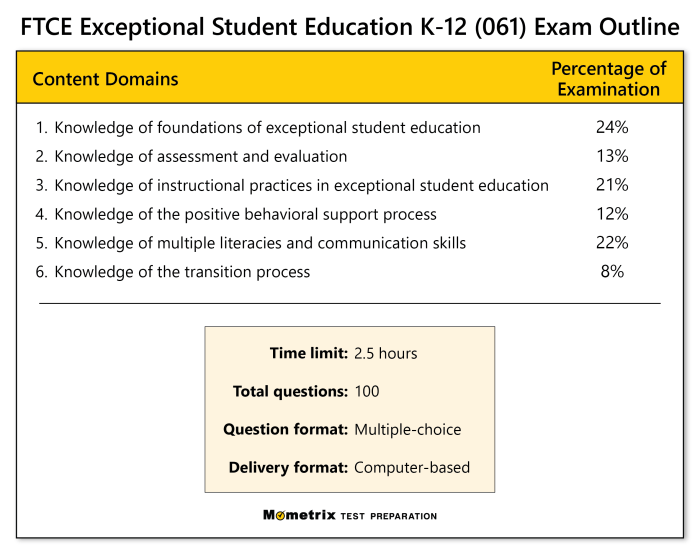
The FTCE Spanish K-12 study guide encompasses four key content domains that provide a comprehensive framework for teaching Spanish language and culture at the elementary and secondary levels.
These domains are:
Communication
- Interpersonal communication: Conversational skills, greetings, introductions, and daily interactions.
- Interpretive communication: Understanding spoken and written Spanish, including comprehension of texts and media.
- Presentational communication: Delivering speeches, presentations, and writing in Spanish.
Culture
- Spanish-speaking cultures: Geography, history, traditions, customs, and beliefs.
- Cultural products and practices: Literature, art, music, and film.
- Cross-cultural perspectives: Understanding and comparing Spanish-speaking cultures with other cultures.
Language Knowledge
- Grammar: Parts of speech, verb tenses, sentence structure, and other grammatical concepts.
- Vocabulary: Building a comprehensive vocabulary in Spanish.
- Phonetics and pronunciation: Understanding and producing Spanish sounds and intonation.
Pedagogy, Ftce spanish k-12 study guide
- Teaching methodologies: Effective strategies for teaching Spanish language and culture.
- Assessment: Techniques for evaluating student learning and progress.
- Technology integration: Utilizing technology to enhance Spanish instruction.
Assessment Strategies
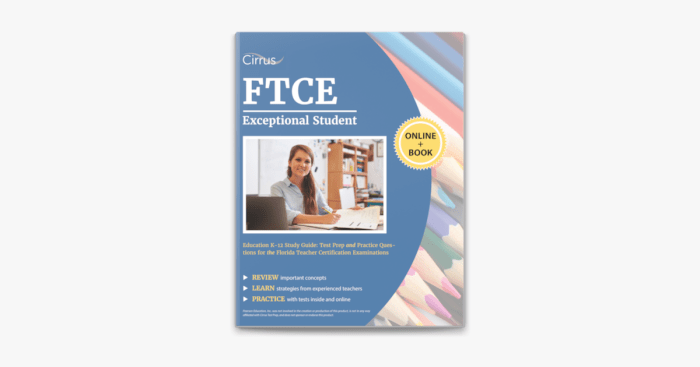
The FTCE Spanish K-12 study guide employs various assessment strategies to evaluate candidates’ proficiency in Spanish language and teaching methodologies. These strategies encompass multiple-choice questions, constructed-response questions, and performance tasks, each designed to assess specific skills and knowledge.
Multiple-Choice Questions
Multiple-choice questions present candidates with a stem or question, followed by several options from which they must select the best answer. These questions assess candidates’ understanding of Spanish grammar, vocabulary, culture, and teaching strategies.
Example:Which of the following is the correct Spanish translation for “the book”?
- El libro
- La libro
- El libros
- La libros
Constructed-Response Questions
Constructed-response questions require candidates to provide written answers to open-ended questions. These questions assess candidates’ ability to apply their knowledge of Spanish and teaching methods to real-world scenarios.
Example:Describe the key components of a communicative language teaching approach and explain how you would implement it in a Spanish classroom.
Performance Tasks
Performance tasks are designed to assess candidates’ ability to perform specific language or teaching skills. These tasks may include oral presentations, written essays, or simulations of classroom scenarios.
Example:Plan and deliver a 10-minute Spanish lesson on the topic of “weather” for a group of beginner-level students.
Study Resources
The FTCE Spanish K-12 exam requires comprehensive preparation to achieve success. To aid in your studies, a diverse range of resources is available to provide support and guidance throughout your journey.
The following list encompasses a variety of study resources tailored to the FTCE Spanish K-12 exam, ensuring you have access to a wealth of materials that cater to your learning style and preferences.
Websites
- Florida Department of Education:Official website providing exam information, practice tests, and study guides.
- Educational Testing Service (ETS):Test administrator with additional resources and practice materials.
- Study.com:Online platform with video lessons, practice tests, and study guides.
- SpanishDict:Comprehensive website with grammar lessons, vocabulary lists, and practice exercises.
Textbooks
- Barron’s FTCE Spanish K-12:Study guide with content review, practice questions, and diagnostic tests.
- Kaplan FTCE Spanish K-12:Textbook with comprehensive coverage of all exam topics, including practice questions.
- REA FTCE Spanish K-12:Textbook with in-depth explanations, practice questions, and full-length practice tests.
Practice Tests
- ETS:Official practice tests available for purchase.
- Study.com:Online practice tests with detailed answer explanations.
- Kaplan:Practice tests with timed conditions and score reports.
Online Courses
- Udemy:Online courses with video lessons, practice questions, and instructor support.
- Coursera:Online courses from top universities, including Spanish language and teaching methodology.
- edX:Online courses with a focus on Spanish grammar, vocabulary, and culture.
Test-Taking Tips: Ftce Spanish K-12 Study Guide
To ace the FTCE Spanish K-12 exam, preparation is crucial. Implement these practical tips and strategies to enhance your performance.
Time Management and Pacing
Time management is essential. Allocate time wisely during the exam to avoid rushing or leaving questions unanswered. Practice answering questions within the time limits to develop a sense of pace.
Stress Reduction Techniques
Stress can hinder your performance. Practice relaxation techniques such as deep breathing or meditation before and during the exam. Stay calm, focus on one question at a time, and don’t let negative thoughts overwhelm you.
Sample Questions
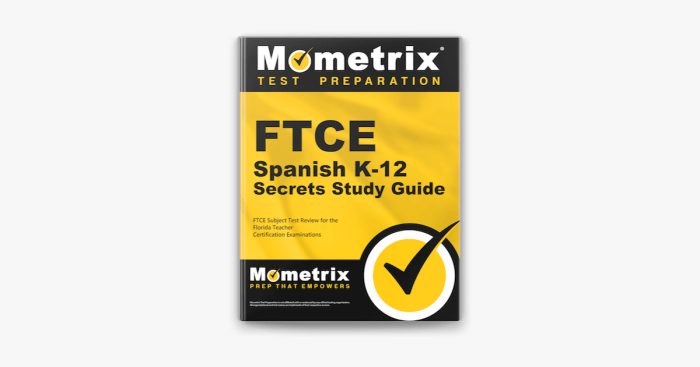
To enhance your preparation for the FTCE Spanish K-12 exam, it is essential to familiarize yourself with the various types of questions you may encounter. This section presents sample questions covering each content domain, providing answer keys and explanations to clarify the concepts being tested.
The FTCE Spanish K-12 study guide is a great resource for preparing for the certification exam. The guide covers all the content areas that will be tested on the exam, including unit 2. To help you assess your progress, check out the unit 2 progress check: frq . This resource provides practice questions that will help you identify areas where you need additional study.
By using the FTCE Spanish K-12 study guide and the unit 2 progress check, you can ensure that you are well-prepared for the certification exam.
The sample questions are carefully designed to reflect the actual exam format and difficulty level, helping you identify your strengths and areas that require further study.
Language Structures
Questions in this domain assess your understanding of Spanish grammar and syntax, including verb conjugations, sentence structure, and parts of speech.
| Question | Answer Key | Explanation |
|---|---|---|
| Translate the sentence: “The students are studying for the test.” | Los estudiantes están estudiando para el examen. | The sentence is in the present progressive tense, using the verb “estar” (to be) and the present participle of the verb “estudiar” (to study). |
| Conjugate the verb “hablar” (to speak) in the preterite tense, third person plural. | Hablaron | The preterite tense is used to describe completed actions in the past. The third person plural ending for regular verbs is “-aron”. |
Reading
Questions in this domain evaluate your ability to comprehend written Spanish texts, including extracting information, making inferences, and understanding the author’s purpose.
| Question | Answer Key | Explanation | |
|---|---|---|---|
| What is the main idea of the following passage? | (Passage provided) | (Main idea identified) | The answer should accurately reflect the central theme or message of the passage. |
| According to the passage, what is the significance of the character’s actions? | (Significance explained) | The answer should demonstrate an understanding of the character’s motivations and the impact of their actions on the plot or theme. |
Listening
Questions in this domain assess your ability to comprehend spoken Spanish, including identifying key details, understanding the speaker’s intent, and making inferences.
| Question | Answer Key | Explanation |
|---|---|---|
| What is the purpose of the speaker’s message? | (Purpose identified) | The answer should accurately reflect the speaker’s intended goal or reason for speaking. |
| According to the speaker, what is the best way to improve your Spanish pronunciation? | (Method explained) | The answer should demonstrate an understanding of the speaker’s advice or recommendations. |
Writing
Questions in this domain evaluate your ability to write clear and grammatically correct Spanish, including composing short essays, writing summaries, and responding to prompts.
| Question | Answer Key | Explanation | |
|---|---|---|---|
| Write a short essay about the importance of studying Spanish. | (Essay provided) | The essay should demonstrate a strong understanding of the topic, logical organization, and correct grammar and usage. | |
| Summarize the following article in 50 words. | (Article provided) | (Summary provided) | The summary should accurately capture the main points of the article, using concise and grammatically correct language. |
Culture
Questions in this domain assess your knowledge of Spanish-speaking cultures, including customs, traditions, and historical events.
| Question | Answer Key | Explanation |
|---|---|---|
| What is the significance of the Day of the Dead in Mexican culture? | (Significance explained) | The answer should demonstrate an understanding of the cultural importance and traditions associated with the holiday. |
| Name three famous Spanish-speaking artists. | (Artists named) | The answer should include notable figures from the fields of art, literature, or music. |
Study Plan
Crafting a well-structured study plan is crucial for FTCE Spanish K-12 exam preparation. It ensures organized and consistent learning, maximizing your chances of success.
Here’s a comprehensive study plan to guide your journey:
Daily Study Hours
Dedicate a minimum of 2-3 hours daily to studying. Break this time into smaller, focused sessions to maintain concentration and maximize retention.
Review Sessions
Regularly schedule review sessions to reinforce what you’ve learned. This helps strengthen your understanding and improves recall.
Practice Tests
Take practice tests throughout your preparation. This simulates the actual exam experience, familiarizes you with the question format, and identifies areas needing improvement.
Additional Resources
In addition to the resources mentioned earlier, there are a number of other resources that can be helpful for candidates preparing for the FTCE Spanish K-12 exam.
These resources include professional development workshops, tutoring services, and study groups.
Professional Development Workshops
Professional development workshops are a great way to learn more about the FTCE Spanish K-12 exam and to get tips on how to prepare for it.
These workshops are typically offered by universities, colleges, and professional organizations.
Tutoring Services
Tutoring services can be a helpful way to get personalized assistance with your FTCE Spanish K-12 exam preparation.
Tutors can help you with a variety of tasks, such as reviewing the content of the exam, practicing test-taking strategies, and improving your Spanish language skills.
Study Groups
Study groups can be a great way to connect with other candidates who are preparing for the FTCE Spanish K-12 exam.
Study groups can provide a supportive environment where you can share ideas, ask questions, and practice test-taking strategies.
Questions Often Asked
What is the purpose of the FTCE Spanish K-12 Study Guide?
To provide comprehensive preparation for the FTCE Spanish K-12 exam, covering all key content domains and assessment strategies.
What are the key content domains covered by the study guide?
Communication, Culture, Literature, Language Acquisition, and Methodology.
What types of assessment strategies are used in the study guide?
Multiple-choice questions, constructed-response questions, and performance tasks.
Where can I find additional resources to supplement my study?
Websites, textbooks, practice tests, online courses, professional development workshops, tutoring services, and study groups.
